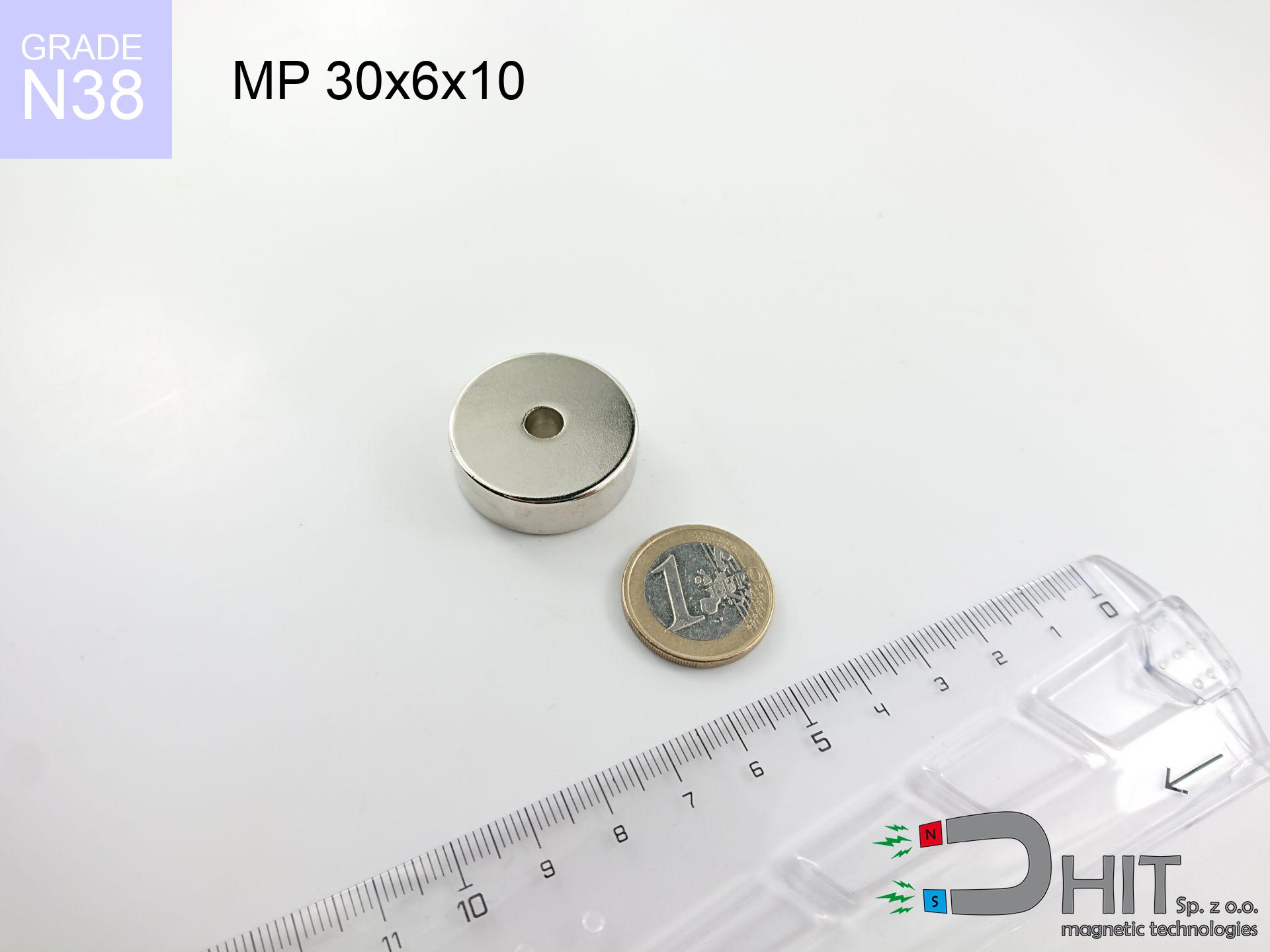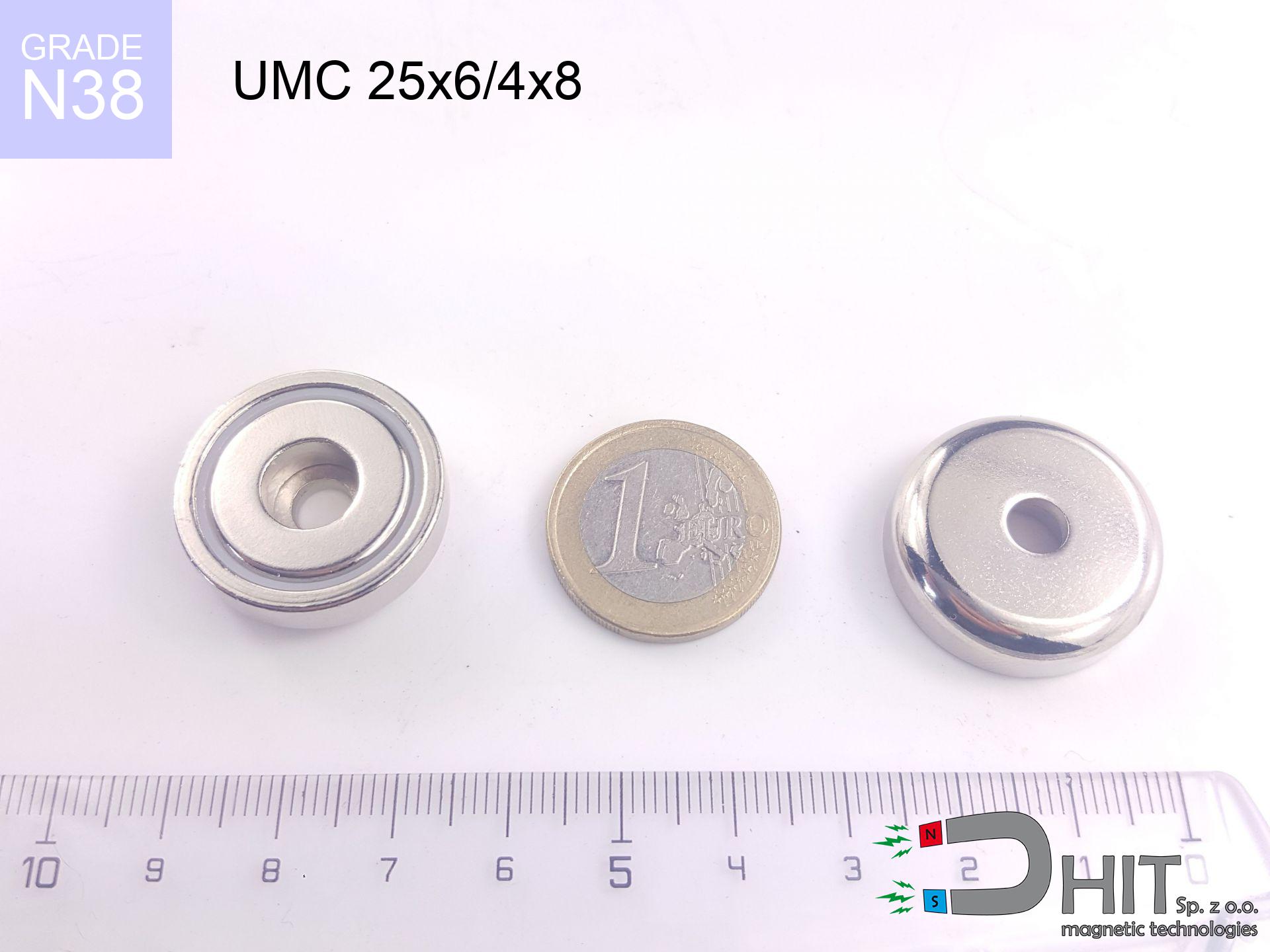UMGGZ 34x6 [M4] GZ / N38 - rubber magnetic holder external thread
rubber magnetic holder external thread
Catalog no 340311
GTIN/EAN: 5906301814733
Diameter Ø
34 mm [±1 mm]
Height
6 mm [±1 mm]
Weight
26 g
Load capacity
7.70 kg / 75.51 N
9.84 ZŁ with VAT / pcs + price for transport
8.00 ZŁ net + 23% VAT / pcs
bulk discounts:
Need more?
Contact us by phone
+48 22 499 98 98
alternatively drop us a message via
contact form
the contact page.
Strength along with shape of a magnet can be analyzed with our
magnetic mass calculator.
Order by 14:00 and we’ll ship today!
Physical properties - UMGGZ 34x6 [M4] GZ / N38 - rubber magnetic holder external thread
Specification / characteristics - UMGGZ 34x6 [M4] GZ / N38 - rubber magnetic holder external thread
| properties | values |
|---|---|
| Cat. no. | 340311 |
| GTIN/EAN | 5906301814733 |
| Production/Distribution | Dhit sp. z o.o. |
| Country of origin | Poland / China / Germany |
| Customs code | 85059029 |
| Diameter Ø | 34 mm [±1 mm] |
| Height | 6 mm [±1 mm] |
| Weight | 26 g |
| Load capacity ~ ? | 7.70 kg / 75.51 N |
| Manufacturing Tolerance | ±1 mm |
Magnetic properties of material N38
| properties | values | units |
|---|---|---|
| remenance Br [min. - max.] ? | 12.2-12.6 | kGs |
| remenance Br [min. - max.] ? | 1220-1260 | mT |
| coercivity bHc ? | 10.8-11.5 | kOe |
| coercivity bHc ? | 860-915 | kA/m |
| actual internal force iHc | ≥ 12 | kOe |
| actual internal force iHc | ≥ 955 | kA/m |
| energy density [min. - max.] ? | 36-38 | BH max MGOe |
| energy density [min. - max.] ? | 287-303 | BH max KJ/m |
| max. temperature ? | ≤ 80 | °C |
Physical properties of sintered neodymium magnets Nd2Fe14B at 20°C
| properties | values | units |
|---|---|---|
| Vickers hardness | ≥550 | Hv |
| Density | ≥7.4 | g/cm3 |
| Curie Temperature TC | 312 - 380 | °C |
| Curie Temperature TF | 593 - 716 | °F |
| Specific resistance | 150 | μΩ⋅cm |
| Bending strength | 250 | MPa |
| Compressive strength | 1000~1100 | MPa |
| Thermal expansion parallel (∥) to orientation (M) | (3-4) x 10-6 | °C-1 |
| Thermal expansion perpendicular (⊥) to orientation (M) | -(1-3) x 10-6 | °C-1 |
| Young's modulus | 1.7 x 104 | kg/mm² |
Material specification
| iron (Fe) | 64% – 68% |
| neodymium (Nd) | 29% – 32% |
| boron (B) | 1.1% – 1.2% |
| dysprosium (Dy) | 0.5% – 2.0% |
| coating (Ni-Cu-Ni) | < 0.05% |
Sustainability
| recyclability (EoL) | 100% |
| recycled raw materials | ~10% (pre-cons) |
| carbon footprint | low / zredukowany |
| waste code (EWC) | 16 02 16 |
Other offers
Advantages as well as disadvantages of Nd2Fe14B magnets.
Pros
- They virtually do not lose power, because even after 10 years the performance loss is only ~1% (according to literature),
- They retain their magnetic properties even under strong external field,
- In other words, due to the metallic layer of gold, the element gains visual value,
- The surface of neodymium magnets generates a unique magnetic field – this is a key feature,
- Made from properly selected components, these magnets show impressive resistance to high heat, enabling them to function (depending on their form) at temperatures up to 230°C and above...
- Considering the potential of accurate shaping and adaptation to individualized requirements, NdFeB magnets can be created in a variety of shapes and sizes, which expands the range of possible applications,
- Universal use in high-tech industry – they are used in mass storage devices, electric motors, advanced medical instruments, as well as multitasking production systems.
- Thanks to concentrated force, small magnets offer high operating force, occupying minimum space,
Limitations
- At strong impacts they can crack, therefore we advise placing them in strong housings. A metal housing provides additional protection against damage, as well as increases the magnet's durability.
- We warn that neodymium magnets can reduce their power at high temperatures. To prevent this, we recommend our specialized [AH] magnets, which work effectively even at 230°C.
- Due to the susceptibility of magnets to corrosion in a humid environment, we suggest using waterproof magnets made of rubber, plastic or other material immune to moisture, when using outdoors
- Due to limitations in producing nuts and complex shapes in magnets, we recommend using cover - magnetic holder.
- Potential hazard resulting from small fragments of magnets pose a threat, when accidentally swallowed, which is particularly important in the aspect of protecting the youngest. It is also worth noting that small components of these magnets can complicate diagnosis medical in case of swallowing.
- High unit price – neodymium magnets have a higher price than other types of magnets (e.g. ferrite), which can limit application in large quantities
Holding force characteristics
Magnetic strength at its maximum – what contributes to it?
- with the application of a yoke made of low-carbon steel, guaranteeing full magnetic saturation
- with a cross-section of at least 10 mm
- with a surface perfectly flat
- with direct contact (without paint)
- for force applied at a right angle (pull-off, not shear)
- at temperature room level
Impact of factors on magnetic holding capacity in practice
- Space between surfaces – every millimeter of distance (caused e.g. by veneer or unevenness) diminishes the magnet efficiency, often by half at just 0.5 mm.
- Force direction – note that the magnet holds strongest perpendicularly. Under shear forces, the capacity drops significantly, often to levels of 20-30% of the maximum value.
- Wall thickness – the thinner the sheet, the weaker the hold. Magnetic flux penetrates through instead of converting into lifting capacity.
- Plate material – low-carbon steel attracts best. Higher carbon content reduce magnetic properties and lifting capacity.
- Smoothness – full contact is possible only on polished steel. Any scratches and bumps create air cushions, weakening the magnet.
- Operating temperature – NdFeB sinters have a negative temperature coefficient. When it is hot they lose power, and at low temperatures gain strength (up to a certain limit).
Lifting capacity was assessed using a smooth steel plate of optimal thickness (min. 20 mm), under perpendicular detachment force, in contrast under shearing force the load capacity is reduced by as much as 5 times. Moreover, even a minimal clearance between the magnet and the plate decreases the holding force.
Safe handling of NdFeB magnets
Combustion hazard
Machining of NdFeB material carries a risk of fire hazard. Neodymium dust oxidizes rapidly with oxygen and is hard to extinguish.
Protect data
Avoid bringing magnets near a wallet, computer, or screen. The magnetic field can destroy these devices and wipe information from cards.
Swallowing risk
NdFeB magnets are not intended for children. Swallowing a few magnets can lead to them connecting inside the digestive tract, which poses a severe health hazard and requires urgent medical intervention.
Pinching danger
Large magnets can smash fingers instantly. Under no circumstances place your hand between two attracting surfaces.
Skin irritation risks
Nickel alert: The nickel-copper-nickel coating consists of nickel. If skin irritation appears, immediately stop working with magnets and use protective gear.
Magnetic interference
Be aware: rare earth magnets produce a field that interferes with precision electronics. Maintain a separation from your phone, device, and navigation systems.
Health Danger
Warning for patients: Strong magnetic fields disrupt medical devices. Maintain minimum 30 cm distance or ask another person to work with the magnets.
Magnets are brittle
Despite metallic appearance, neodymium is delicate and not impact-resistant. Do not hit, as the magnet may shatter into sharp, dangerous pieces.
Thermal limits
Standard neodymium magnets (grade N) undergo demagnetization when the temperature goes above 80°C. Damage is permanent.
Caution required
Before use, read the rules. Uncontrolled attraction can destroy the magnet or injure your hand. Be predictive.

![Rubber coated magnetic holder UMGGZ 34x6 [M4] GZ / N38 Rubber coated magnetic holder UMGGZ 34x6 [M4] GZ / N38](https://cdn3.dhit.pl/graphics/banners/magnet.webp)
![UMGGZ 34x6 [M4] GZ / N38 - rubber magnetic holder external thread](https://cdn3.dhit.pl/graphics/products/umg-34x6-m4-gz-rad.jpg)





